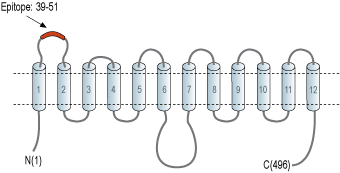Overview
- Peptide (C)KEFINKTLTDKGN, corresponding to amino acid residues 39-51 of human GLUT3 (Accession P11169). 1st extracellular loop.

- Lacombe, V.A. (2014) ISRN Vet. Sci. 2014, 409547.
- Simpson, I.A. et al. (2008) Am J. Physiol. 295, E242.
- Zheng, C. et al. (2016) Oncol. Lett. 12, 125.
The GLUT protein family is encoded by the SLC2 genes and is a member of the major facilitator superfamily of membrane transporters. GLUTs are recognized as key regulators of whole-body glucose homeostasis, and are responsible for the uptake of carbohydrate-derived glucose by cells. There are 14 GLUT isoforms divided into 3 different group classes based on sequence similarity and structural and functional characteristics1,2.
GLUT3 is a low-Km protein responsible for glucose uptake into neurons. It is predominantly expressed in neurons and is commonly called “neuronal glucose transporter". The protein contains 12 membrane-spanning domains, an N-linked glycosylation site in loop 1 responsible for high-affinity transport of glucose, and intracellular NH2- and COOH- termini. In addition, there are several conserved residues and motifs designated “sugar transporter signatures”1,2.
GLUT3 levels are high in some malignant glioma cells compared to normal glial cells and therefore may be used as a therapeutic target in some cancer treatment3.
Application key:
Species reactivity key:
Anti-Human GLUT3 (extracellular) Antibody (#AGT-043) is a highly specific antibody directed against an epitope of the human protein. The antibody can be used in western blot and live cell flow cytometry applications. The antibody has been designed to recognize GLUT3 from human samples only. This antibody will also recognize the human paralog GLUT14 /SLC2A14.
Anti-Human GLUT3 (extracellular)-FITC Antibody (#AGT-043-F) is directly conjugated to fluorescein isothiocyanate (FITC). The antibody can be used in immunofluorescent applications such as direct live cell flow cytometry.

